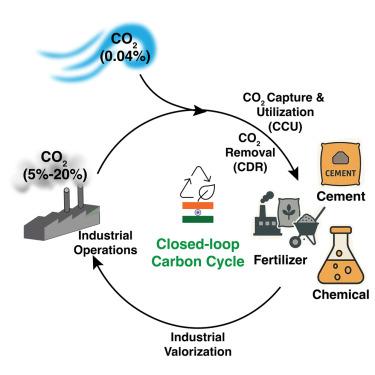气候和能源弹性印度的闭环碳管理战略
IF 4.1
2区 综合性期刊
Q1 MULTIDISCIPLINARY SCIENCES
引用次数: 0
摘要
气候变化主要是由过量二氧化碳排放造成的,构成了紧迫的全球挑战。印度每年的二氧化碳排放量超过26亿吨,其中约80%来自难以减排的行业,如电力、水泥、石化、化工和钢铁。这篇综述强调了碳捕集、利用和封存(CCUS)和二氧化碳去除(CDR)技术的重要性,它们是使印度的增长与气候目标保持一致的关键途径。印度优先考虑从烟道气中进行点源捕获,这反映了其集中排放的概况。有效的碳管理模式必须产生高价值的可销售产品,包括燃料、肥料、骨料和建筑材料,以支持闭环碳循环。矿化途径使基于二氧化碳的建筑材料能够加强智慧城市和基础设施倡议,而二氧化碳衍生肥料可以提高农业生产力和粮食安全。报告还考察了印度新兴的碳市场,提出了平衡的强制性和自愿性机制、碳信用激励和利用驱动的副产品的建议。总的来说,它为印度提供了一个综合的CCUS框架,将减排与经济可行性结合起来,并为其他发展中经济体提供可扩展的见解。本文章由计算机程序翻译,如有差异,请以英文原文为准。

Closed-loop carbon management strategies for climate and energy-resilient India
Climate change, primarily driven by excessive CO2 emissions, poses urgent global challenges. India contributes over 2,600 Mt CO2 annually, with ∼80% originating from hard-to-abate sectors, such as power, cement, petrochemical, chemical, and steel. This review highlights the importance of carbon capture, utilization, and storage (CCUS) and carbon dioxide removal (CDR) technologies as critical pathways to align India’s growth with climate goals. India prioritizes point-source capture from flue gases, reflecting its concentrated emission profile. Effective carbon management models must generate high-value marketable products, including fuels, fertilizers, aggregates, and construction materials, supporting a closed-loop carbon cycle. Mineralization pathways enable CO2-based building materials to strengthen Smart City and infrastructure initiatives, while CO2-derived fertilizers enhance agricultural productivity and food security. The manuscript also examines India’s emerging carbon market, recommending balanced compulsory and voluntary mechanisms, carbon credit incentives, and utilization-driven byproducts. Collectively, it provides an integrated CCUS framework for India that couples emission reduction with economic viability and offers scalable insights for other developing economies.
求助全文
通过发布文献求助,成功后即可免费获取论文全文。
去求助
来源期刊

iScience
Multidisciplinary-Multidisciplinary
CiteScore
7.20
自引率
1.70%
发文量
1972
审稿时长
6 weeks
期刊介绍:
Science has many big remaining questions. To address them, we will need to work collaboratively and across disciplines. The goal of iScience is to help fuel that type of interdisciplinary thinking. iScience is a new open-access journal from Cell Press that provides a platform for original research in the life, physical, and earth sciences. The primary criterion for publication in iScience is a significant contribution to a relevant field combined with robust results and underlying methodology. The advances appearing in iScience include both fundamental and applied investigations across this interdisciplinary range of topic areas. To support transparency in scientific investigation, we are happy to consider replication studies and papers that describe negative results.
We know you want your work to be published quickly and to be widely visible within your community and beyond. With the strong international reputation of Cell Press behind it, publication in iScience will help your work garner the attention and recognition it merits. Like all Cell Press journals, iScience prioritizes rapid publication. Our editorial team pays special attention to high-quality author service and to efficient, clear-cut decisions based on the information available within the manuscript. iScience taps into the expertise across Cell Press journals and selected partners to inform our editorial decisions and help publish your science in a timely and seamless way.
 求助内容:
求助内容: 应助结果提醒方式:
应助结果提醒方式:


